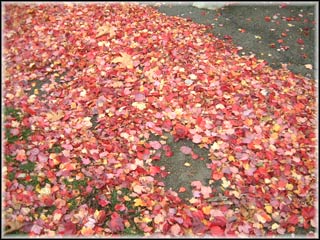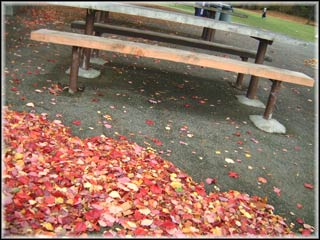Goodbye to Summer
10.18.04

The breeze blew in, and I said goodbye to summer.
Okay, so summer 'officially' ended a full month ago. But here in San Francisco, where the summerish sun often doesn't start cutting through the fog until late-August and holds its warmth out through about, say, mid-October, it was only this past week when I detected that chilly specter in the air. I went to sleep one night last week, my windows wide open from that day's heat spell, and awakened the next morning to a cold room and the unmistakable smell of autumn. And then it rained. I suppose I should have welcomed this new climatic period, ushered in on a breezy snap… but instead I felt like I was saying goodbye to something else, bidding adieu to beach weather and evening walks in the park and sleeping with the windows wide open.
'It
turned colder, that's where it ends… Summer dreams, ripped at
the seams…'
—'Summer Nights', John Travolta & Olivia Newton-John, Grease
soundtrack.
Grease is one of my favorite movies of all time, and it sticks to a narrative pattern similar to so many films that follow the school-year schedule. The action begins as summer fun ends and main characters Sandy and Danny must return to high school, the practical autumnal business of their lives. When they unexpectedly discover they go to the same school, the two summer-lovebirds must adapt their usual schoolyard behaviors to each other's presence. For a while, it's a painful adjustment—Danny behaves boorishly to impress his friends, Sandy responds with hysterical scorn, the two remain at odds. It isn't until the days brighten and the weather warms again, when spring returns in full bloom and the film hits its climax, that the lovers finally reunite.
The chronological arc moves from summertime bliss, through narrative complication and emotional descent, into springtime renewal… and in this metaphor, fall is the season that complicates matters and pressures us to reconsider submerged elements of our consciousness. The progression of the zodiac signs reflects this narrative movement. Leo is the joyous height of the summer, the unambiguous ego brilliance from which the protagonist will proceed to fall. At late summer's Virgo comes the deferent retreat to the call of duty, a time to efficiently prepare for the work of harvest. Libra marks the meeting with other, the confrontation at which self must compromise and concede—to lovers, collaborators, obligations or social protocols—and though there are obvious benefits to conjoining forces into unity, there's also an inherent giving-up. (This matches that sense of saying goodbye I experienced when the autumnal breeze blew in.)
Then, at Scorpio, the meeting deepens and turns messy. It gets psychologically uncomfortable, as power differentials appear and the fullness of our passions ripens. Maybe resentment or lust develops. The old issues are dredged up. We must cope with the losses from those little deaths in compromise and concession. We mourn. Hopefully, we heal.
On
Friday evening, the Sun enters Scorpio and escorts us further into
fall, where we face an increasing chill and the intensifying transformation
of our psyches in response to whatever outside ourselves we recently
met. These past few weeks have been deeply Libran,
 forefronting the importance of such meetings with external forces,
impelling us to give a little and take a little and modify our behaviors
to fit the middle course. For the time being, we've gained assistance
but lost some freedom.
forefronting the importance of such meetings with external forces,
impelling us to give a little and take a little and modify our behaviors
to fit the middle course. For the time being, we've gained assistance
but lost some freedom.
Scorpio unleashes our complex psychological reactions to the give and take—do we want to dominate or submit, devour or devolve, kill or fuck or shit, or eventually gain strength and power from deep sharing? Scorpio invokes the death within life, the ugly indivisible from the beauty, our most unsavory sentiments as inseparable from the whole of who we are. Leaves fall. Light wanes. We hide ourselves under heavier coats and sweaters and scarves, letting go of the summer's joyous memories, preparing for the approaching holidays and a long winter ahead.
In horary astrology, the branch that casts divinatory charts to answer specific questions (i.e., 'Will this business deal go through?'), the segment of the zodiac wheel from 15 degrees Libra to 15 degrees Scorpio is called the Via Combusta (or 'fiery way') and is considered to be a difficult or malevolent influence. When reading an horary chart, any answer is traditionally considered unreliable if the Moon is passing through the Via Combusta at the time the question is posed. This zodiac range, which is where the Sun is currently situated, is a dark zone connected with all things hidden from visibility—the deceased, for instance, as well as our own subconscious psychological motivations—and its effect in horary astrology is seen as a passing warning against waging judgment. When the Sun reaches 15 Scorpio, the final peak of the Via Combusta, we celebrate Samhain, the pagan precursor to Halloween, a celebration of death during which the curtain between the living and the deceased is said to be at its faintest of the year. Leading up to Samhain, as we are now, that curtain grows thinner and we increase our contact with the unseen, the unknown and the unexplained.
We up north mustn't forget that, though this same zodiac progression continues uniformly around the world, its seasonal equivalents are reversed in the southern hemisphere. As we bid adieu to our longer, warmer days, our southerly pals are currently greeting spring with shorter shirt-sleeves and hopping hormones. The symbolic connections between the zodiac signs and their corresponding seasons, as I've learned them, fit more cleanly with the northern hemisphere experience, as astrology's foundation can be traced to ancient cultures who lived north of the equator. I leave it to my southern hemispheric astro-comrades to forge more effective thematic links between the zodiac symbolism and their lived experience down under.
I, for one, judge the Scorpio season by the breeze in my bedroom and the ghosts who ride on the tail of that wind, reminding me that everything is not always as it appears on the surface.


